It’s at the Ploughing when farmers who have been thinking of making mid-sized investments on their farm will finally take the plunge. While cashflow is a concern for many beef and sheep farmers, two of the biggest meal bin manufacturers in the country are reporting strong farmer demand for bins of all shapes and sizes.
Waiting lists for meal bins are anywhere from six to eight weeks depending on the manufacturer, so farmers hoping to have one for the coming winter must act now.
Two of the biggest manufacturers of meal bins in Ireland are McAree Engineering, known for their V-Mac range, and Crowley Engineering.
Meal bins have been eligible for grant aid to dairy farmers for a number of years. However, in early 2019 this was expanded to include farmers of all enterprises, including beef, sheep and pig farmers. One unintended consequence of this was a slow in meal bin purchases for the first half of the year, as farmers waited for TAMS (Targeted Agricultural Modernisation Scheme) approval.
Through TAMS, farmers are eligible for a grant aid of 40% for a general applicant and 60% for a young farmer. This has made this size of an investment much more palatable.
The safety aspect is also important to look at. There are more elderly farmers on farms and meal-feeding can be a very labour intensive job, especially where a large number of cattle are being finished.
Using a meal bin means that gravity can look after the heavy lifting when it comes to filling a wheelbarrow, loader bucket or quad and snacker.
V-Mac Silos
Eamon McMeel from McAree Engineering has seen a change in the type of bins that farmers are buying;
“Split bins would be very popular with us. We are seeing a lot more farmers going for a higher spec bin due to the grant aid available.
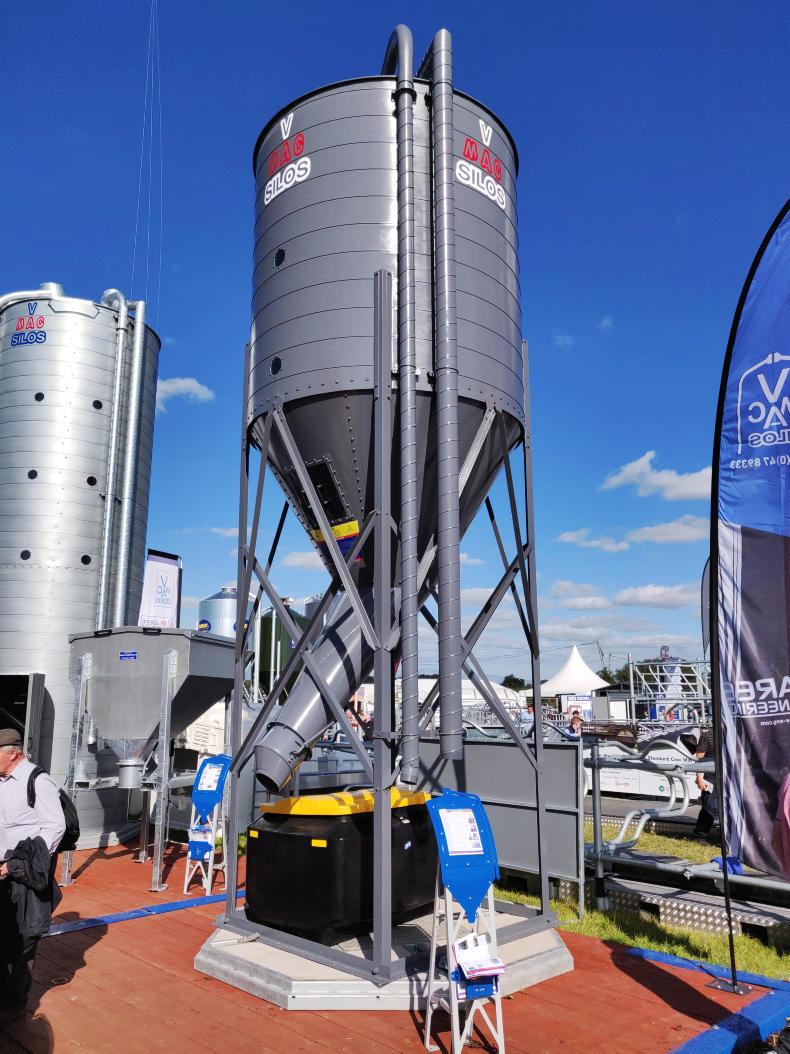
The V-Mac split bins have become a popular option among farmers.
"We are selling a lot of binning augers, as farmers are willing to spend that bit more knowing they will get the grant on it.” The auger can be used to pump meal into a diet feeder.
“The most popular bins that we are selling are probably in the 10t to 12t range. The smallest split bin that we would do is 8t, while the smallest we would go with a straight bin is 5t”, Eamon continued.
While many farmers will be interested in a standard meal bin, one option that has proved popular over the past year is the Tote bin.
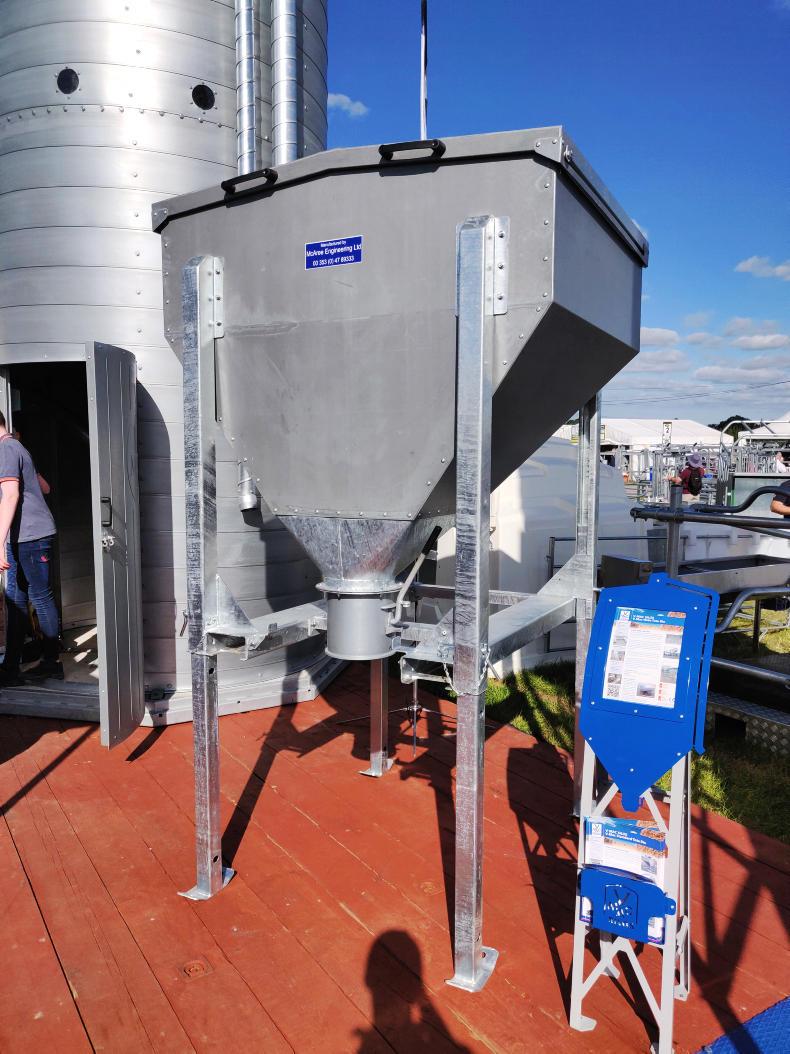
The Tote bin has the capacity to hold 1t of meal.
It has a capacity of 1t or 1.5m3 with telescopic legs which allow it to stand 80cm or 1m off the ground, making it suitable to fill wheelbarrows or buckets from. The bin comes at a price of €875 plus VAT.
Another option available from McAree is the enclosed bin, which is useful for farmers filling into bags or wheelbarrows.

Enclosed bins are a good way to keep vermin out.
It offers protection against the elements, but also helps to keep vermin away from meal.
Crowley
Crowley Engineering are the other main manufacturer of meal bins in the country. Noel Daly has seen a similar change in the size of bins selling well with farmers.
“It used to be a 6t bin that farmers would go for, but now that has pushed up to a 7.5t or an 8.5t bin. When it comes to what size bin beef farmers should use, we would generally advise to look at how much feed you use in three to four weeks and go 1-2t more,” Noel said.
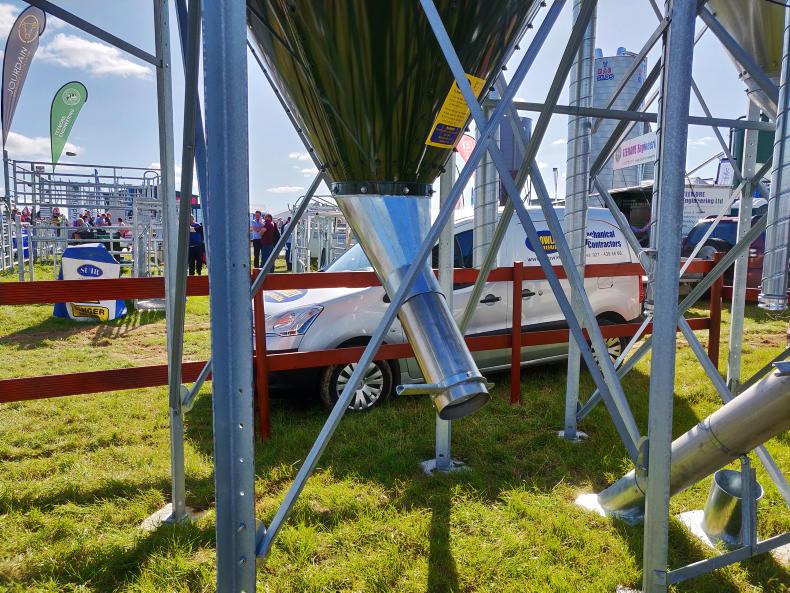
Crowley Engineering have the option of a short spout on their bins.
Crowley has a few different options when it comes to the offset bin, with the choice to have a longer or shorter spout coming from the bin. The diameter of these spouts can be either 200mm or 300mm, whichever is preferred.
The shorter spout would be suited to filling a wheelbarrow or bags, while the longer spout is useful if filling into the bucket of a loader or plastic meal bin.
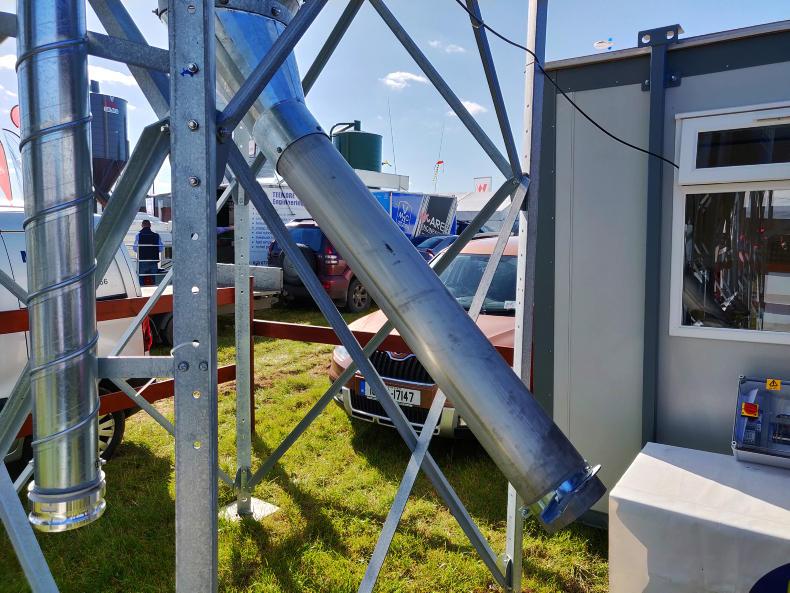
The longer spout can be an additional €100.
These plastic bins, which are very popular on farms, generally have capacity for 650kg of meal and cost approximately €300 to €370 including VAT. One drawback is that it can be difficult to empty when meal levels run low .
Crowley Engineering generally focuses more on straight bins, with split bins only available at 22t or bigger.
“We have a camlock connection as standard on all bins to attach to when meal is being filled,” Noel said.
On many dairy farms where expansion has occured, the current meal bin is simply not big enough to cope with the size of the herd. Crowley Engineering has some recommendations for meal bin size based on the size of the herd, which can be seen in Table 2.
When using feed silos, the advice is generally to avoid coarse rations and nuts with high levels of molasses, as these types of feed can easily clog up a silo.
TAMS requirements
One of the key requirements through TAMS is to have the bin painted. However, if the bin is to be constructed in a shed, it does not need to be painted.
Meal bins must be bolted to a minimum 3m by 3m concrete base that is at least 250mm thick. Concrete must be at least 37N (Mix B). The reference cost for a meal bin constructed on a new base is calculated using the following equation; reference cost = (capacity of the bin in m3 x €68.51) plus €2,202. For a bin on an existing base, this add on to the above equation is only €1,900.
For example, if there is a 8m3 meal bin, it would have a reference cost of (8 x €68.51) + €2,202 = €2,750.08. This rate includes the meal bin, concrete pad and installation.
As a rough guide to calculate the required capacity of the bin, multiply the required tonnage by 1.39 to get the required volume in m3. The actual volume for a given tonnage will vary depending on the type of meal stored.
Table 3 gives a rough breakdown of the costs of various sized meal bins. However, these costs do not include painting. In general, painting can cost anywhere from €300 to €500, depending on the size of the bin.
It’s at the Ploughing when farmers who have been thinking of making mid-sized investments on their farm will finally take the plunge. While cashflow is a concern for many beef and sheep farmers, two of the biggest meal bin manufacturers in the country are reporting strong farmer demand for bins of all shapes and sizes.
Waiting lists for meal bins are anywhere from six to eight weeks depending on the manufacturer, so farmers hoping to have one for the coming winter must act now.
Two of the biggest manufacturers of meal bins in Ireland are McAree Engineering, known for their V-Mac range, and Crowley Engineering.
Meal bins have been eligible for grant aid to dairy farmers for a number of years. However, in early 2019 this was expanded to include farmers of all enterprises, including beef, sheep and pig farmers. One unintended consequence of this was a slow in meal bin purchases for the first half of the year, as farmers waited for TAMS (Targeted Agricultural Modernisation Scheme) approval.
Through TAMS, farmers are eligible for a grant aid of 40% for a general applicant and 60% for a young farmer. This has made this size of an investment much more palatable.
The safety aspect is also important to look at. There are more elderly farmers on farms and meal-feeding can be a very labour intensive job, especially where a large number of cattle are being finished.
Using a meal bin means that gravity can look after the heavy lifting when it comes to filling a wheelbarrow, loader bucket or quad and snacker.
V-Mac Silos
Eamon McMeel from McAree Engineering has seen a change in the type of bins that farmers are buying;
“Split bins would be very popular with us. We are seeing a lot more farmers going for a higher spec bin due to the grant aid available.

The V-Mac split bins have become a popular option among farmers.
"We are selling a lot of binning augers, as farmers are willing to spend that bit more knowing they will get the grant on it.” The auger can be used to pump meal into a diet feeder.
“The most popular bins that we are selling are probably in the 10t to 12t range. The smallest split bin that we would do is 8t, while the smallest we would go with a straight bin is 5t”, Eamon continued.
While many farmers will be interested in a standard meal bin, one option that has proved popular over the past year is the Tote bin.

The Tote bin has the capacity to hold 1t of meal.
It has a capacity of 1t or 1.5m3 with telescopic legs which allow it to stand 80cm or 1m off the ground, making it suitable to fill wheelbarrows or buckets from. The bin comes at a price of €875 plus VAT.
Another option available from McAree is the enclosed bin, which is useful for farmers filling into bags or wheelbarrows.

Enclosed bins are a good way to keep vermin out.
It offers protection against the elements, but also helps to keep vermin away from meal.
Crowley
Crowley Engineering are the other main manufacturer of meal bins in the country. Noel Daly has seen a similar change in the size of bins selling well with farmers.
“It used to be a 6t bin that farmers would go for, but now that has pushed up to a 7.5t or an 8.5t bin. When it comes to what size bin beef farmers should use, we would generally advise to look at how much feed you use in three to four weeks and go 1-2t more,” Noel said.

Crowley Engineering have the option of a short spout on their bins.
Crowley has a few different options when it comes to the offset bin, with the choice to have a longer or shorter spout coming from the bin. The diameter of these spouts can be either 200mm or 300mm, whichever is preferred.
The shorter spout would be suited to filling a wheelbarrow or bags, while the longer spout is useful if filling into the bucket of a loader or plastic meal bin.

The longer spout can be an additional €100.
These plastic bins, which are very popular on farms, generally have capacity for 650kg of meal and cost approximately €300 to €370 including VAT. One drawback is that it can be difficult to empty when meal levels run low .
Crowley Engineering generally focuses more on straight bins, with split bins only available at 22t or bigger.
“We have a camlock connection as standard on all bins to attach to when meal is being filled,” Noel said.
On many dairy farms where expansion has occured, the current meal bin is simply not big enough to cope with the size of the herd. Crowley Engineering has some recommendations for meal bin size based on the size of the herd, which can be seen in Table 2.
When using feed silos, the advice is generally to avoid coarse rations and nuts with high levels of molasses, as these types of feed can easily clog up a silo.
TAMS requirements
One of the key requirements through TAMS is to have the bin painted. However, if the bin is to be constructed in a shed, it does not need to be painted.
Meal bins must be bolted to a minimum 3m by 3m concrete base that is at least 250mm thick. Concrete must be at least 37N (Mix B). The reference cost for a meal bin constructed on a new base is calculated using the following equation; reference cost = (capacity of the bin in m3 x €68.51) plus €2,202. For a bin on an existing base, this add on to the above equation is only €1,900.
For example, if there is a 8m3 meal bin, it would have a reference cost of (8 x €68.51) + €2,202 = €2,750.08. This rate includes the meal bin, concrete pad and installation.
As a rough guide to calculate the required capacity of the bin, multiply the required tonnage by 1.39 to get the required volume in m3. The actual volume for a given tonnage will vary depending on the type of meal stored.
Table 3 gives a rough breakdown of the costs of various sized meal bins. However, these costs do not include painting. In general, painting can cost anywhere from €300 to €500, depending on the size of the bin.









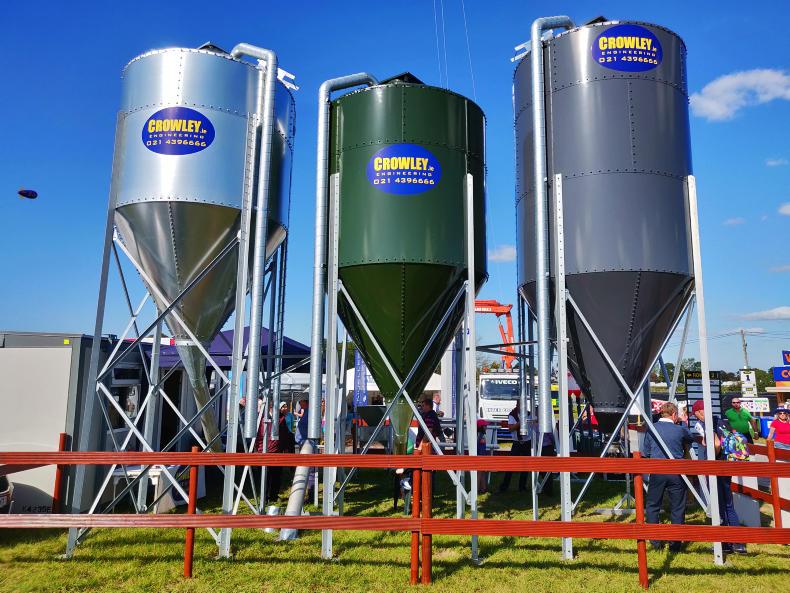
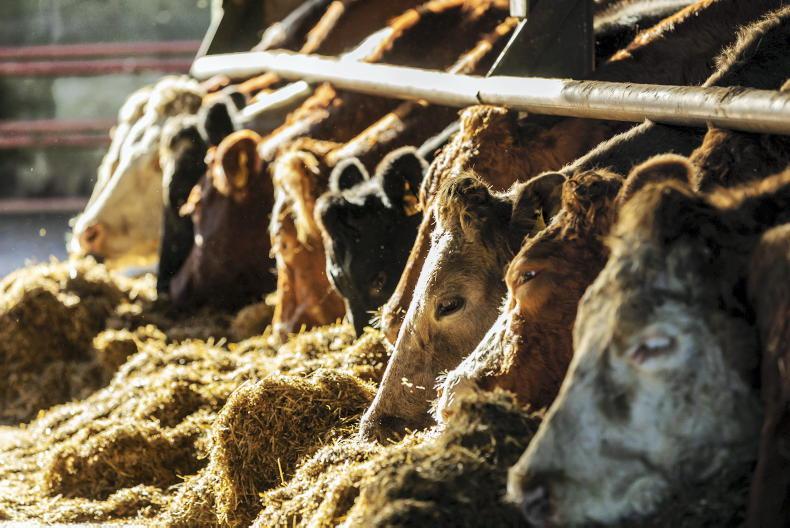

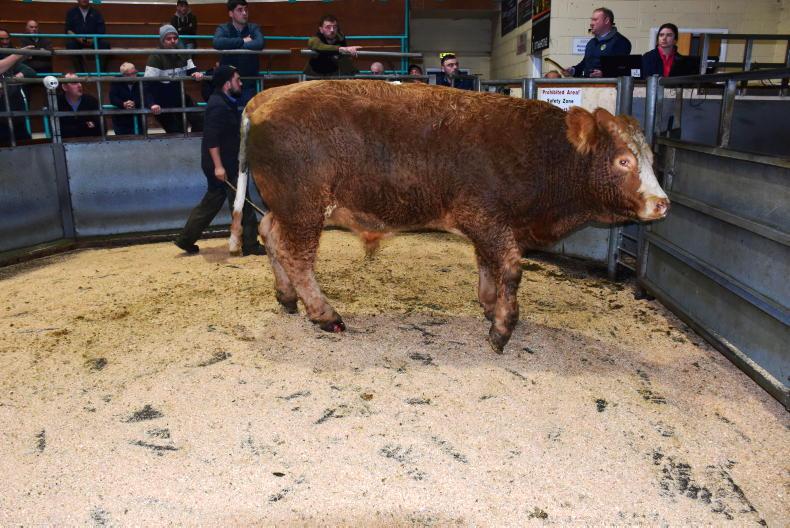
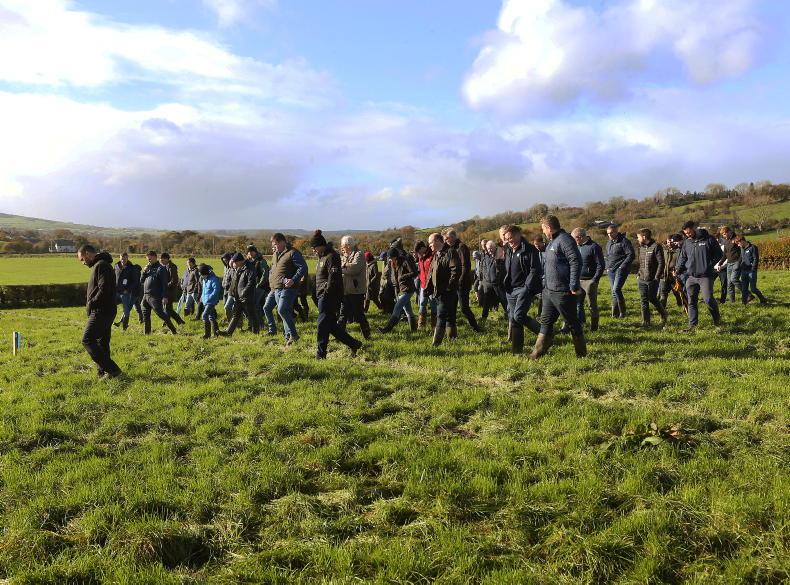
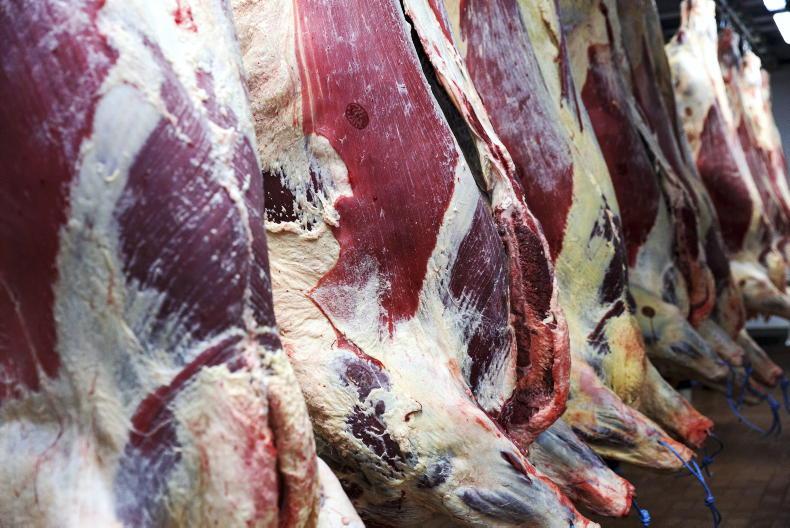
SHARING OPTIONS